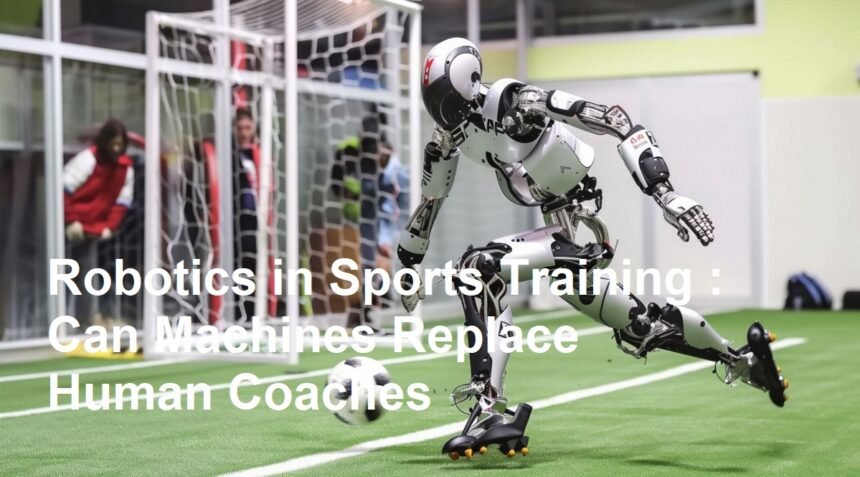Introduction
From self-driving cars to robotic surgeons, technology is stepping into areas we never imagined. Now, it’s making its way into the world of sports. With robotics in sports training, athletes are being introduced to a new kind of coach—machines that can track, analyze, and even provide feedback in real time.
But the big question remains: can robots actually replace human coaches? Or are they simply powerful assistants that push athlete performance to the next level? Let’s break it down, explore the rise of smart coaching robots, and see what this means for the future of training.
The Rise of Robotics in Sports Training
Why Robots Are Entering the Game
Athletes need precise, data-driven training to stay competitive. Robotics provides consistency, accuracy, and objectivity—things human coaches can sometimes struggle to maintain. A robot can repeat drills perfectly hundreds of times or measure micro-movements too small for the human eye.
Practical Tip: If you’re an athlete, start by exploring robotic tools that complement your training—like ball-launching robots in tennis or swing-analyzing devices in golf.
Real Examples of Robotics in Sports
- Tennis Robots: Machines that serve balls at varying speeds and angles for practice.
- Soccer Robots: Used for passing and dribbling drills with precise accuracy.
- Wearable Robotics: Exoskeletons that help athletes recover or train more effectively.
Smart Coaching Robots: How They Work
Tracking and Data Collection
Smart robots use sensors, cameras, and AI algorithms to collect data on athlete movements, speed, endurance, and reaction time.
Practical Tip: Athletes can use this feedback to identify weaknesses. For example, a sprinter might learn that their left leg pushes off 10% weaker than their right—something a coach could miss.
Real-Time Feedback
Instead of waiting for video reviews, smart coaching robots can instantly suggest adjustments, like correcting posture or modifying swing angles.
Personalized Training Programs
Robots can adapt drills based on individual performance, making training highly customized.
Can Robots Replace Human Coaches?
The Strengths of Robots
- Consistency: Robots don’t get tired or emotional.
- Data Accuracy: Advanced sensors detect tiny performance changes.
- Availability: Robots can be used anytime, without scheduling conflicts.
The Limitations of Robots
- Lack of Human Touch: Motivation, empathy, and inspiration are still human qualities.
- Contextual Judgment: A coach understands an athlete’s mental state—something robots can’t truly replicate.
- Creativity: Strategy and adaptability in sports still require human intuition.
Practical Tip: Think of robotics as assistants, not replacements. Athletes should use robots for repetitive drills and data analysis, while relying on human coaches for strategy and emotional support.
Robotics and Athlete Performance
Enhancing Precision and Skills
Robots help athletes perfect their techniques by ensuring consistency in drills. For example, basketball shooting robots can rebound and return the ball with pinpoint accuracy, allowing players to focus solely on their form.
Injury Prevention and Recovery
Robots can monitor fatigue levels and biomechanics to prevent overtraining. Rehabilitation robots and exoskeletons are also speeding up recovery for injured athletes.
Practical Tip: If you’re recovering from an injury, ask your physiotherapist about robotic rehab tools. They can help restore mobility and strength more safely.
Mental Conditioning
Some smart robots simulate high-pressure game scenarios, helping athletes build mental resilience.
Challenges in Adopting Robotics in Sports
High Costs
Advanced robots are still expensive, making them accessible mostly to elite teams and wealthy institutions.
Tip for Athletes: Start with affordable robotic tools like AI-enabled wearables or motion trackers before investing in high-end robots.
Resistance to Change
Some coaches and athletes are skeptical, fearing that robots might replace human expertise. Building trust in the technology is key.
Ethical Questions
Who owns the performance data collected by robots? Protecting athlete privacy is a growing concern.
Practical Tips for Athletes and Coaches
For Athletes
- Use Robots for Repetition: Perfect drills like serves, shots, or passes with robotic assistance.
- Combine Data with Feel: Use robot-generated feedback but still trust your instincts.
- Track Progress: Regularly compare your robotic data reports to measure improvement.
For Coaches
- Leverage Robots for Analysis: Use robotics to gather insights and then add human interpretation.
- Focus on Motivation: Let robots handle the repetitive tasks while you provide inspiration and strategy.
- Stay Updated: Keep learning about new robotics tools that can support your training methods.
The Future of Robotics in Sports Training
Integration with AI and Wearables
Robots combined with AI and wearable devices will create a holistic picture of athlete performance—from physical stats to recovery needs.
Accessible to Everyone
As technology becomes cheaper, robotics in sports training won’t just be for pros. Even youth athletes may soon use them in schools and clubs.
Blended Coaching
The future likely won’t be “robots vs. humans,” but rather “robots + humans.” Together, they’ll form the ultimate coaching duo.
Conclusion: Robots as Partners, Not Replacements
The future of robotics in sports training is exciting, but machines are not here to replace human coaches entirely. Instead, smart coaching robots serve as powerful assistants—improving athlete performance, preventing injuries, and providing data-driven insights. Human coaches, meanwhile, remain irreplaceable when it comes to strategy, motivation, and emotional support.
Now it’s your turn! Would you trust a robot to train you, or do you still prefer the guidance of a human coach? Share your thoughts in the comments below!












